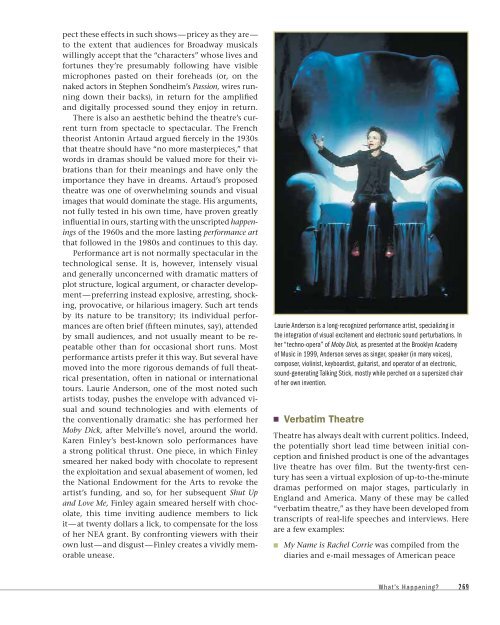Theatre Today: Where Can You Find It?
Theatre Today: Where Can You Find It?
Theatre Today: Where Can You Find It?
You also want an ePaper? Increase the reach of your titles
YUMPU automatically turns print PDFs into web optimized ePapers that Google loves.
pect these effects in such shows — pricey as they are —<br />
to the extent that audiences for Broadway musicals<br />
willingly accept that the “characters” whose lives and<br />
fortunes they’re presumably following have visible<br />
microphones pasted on their foreheads (or, on the<br />
naked actors in Stephen Sondheim’s Passion, wires running<br />
down their backs), in return for the amplifi ed<br />
and digitally processed sound they enjoy in return.<br />
There is also an aesthetic behind the theatre’s current<br />
turn from spectacle to spectacular. The French<br />
theorist Antonin Artaud argued fi ercely in the 1930s<br />
that theatre should have “no more masterpieces,” that<br />
words in dramas should be valued more for their vibrations<br />
than for their meanings and have only the<br />
importance they have in dreams. Artaud’s proposed<br />
theatre was one of overwhelming sounds and visual<br />
images that would dominate the stage. His arguments,<br />
not fully tested in his own time, have proven greatly<br />
infl uential in ours, starting with the unscripted happenings<br />
of the 1960s and the more lasting performance art<br />
that followed in the 1980s and continues to this day.<br />
Performance art is not normally spectacular in the<br />
technological sense. <strong>It</strong> is, however, intensely visual<br />
and generally unconcerned with dramatic matters of<br />
plot structure, logical argument, or character development<br />
— preferring instead explosive, arresting, shocking,<br />
provocative, or hilarious imagery. Such art tends<br />
by its nature to be transitory; its individual performances<br />
are often brief (fi fteen minutes, say), attended<br />
by small audiences, and not usually meant to be repeatable<br />
other than for occasional short runs. Most<br />
performance artists prefer it this way. But several have<br />
moved into the more rigorous demands of full theatrical<br />
presentation, often in national or international<br />
tours. Laurie Anderson, one of the most noted such<br />
artists today, pushes the envelope with advanced visual<br />
and sound technologies and with elements of<br />
the conventionally dramatic: she has performed her<br />
Moby Dick, after Melville’s novel, around the world.<br />
Karen Finley’s best-known solo performances have<br />
a strong political thrust. One piece, in which Finley<br />
smeared her naked body with chocolate to represent<br />
the exploitation and sexual abasement of women, led<br />
the National Endowment for the Arts to revoke the<br />
artist’s funding, and so, for her subsequent Shut Up<br />
and Love Me, Finley again smeared herself with chocolate,<br />
this time inviting audience members to lick<br />
it — at twenty dollars a lick, to compensate for the loss<br />
of her NEA grant. By confronting viewers with their<br />
own lust — and disgust — Finley creates a vividly memorable<br />
unease.<br />
Laurie Anderson is a long-recognized performance artist, specializing in<br />
the integration of visual excitement and electronic sound perturbations. In<br />
her “techno-opera” of Moby Dick, as presented at the Brooklyn Academy<br />
of Music in 1999, Anderson serves as singer, speaker (in many voices),<br />
composer, violinist, keyboardist, guitarist, and operator of an electronic,<br />
sound-generating Talking Stick, mostly while perched on a supersized chair<br />
of her own invention.<br />
� Verbatim <strong>Theatre</strong><br />
<strong>Theatre</strong> has always dealt with current politics. Indeed,<br />
the potentially short lead time between initial conception<br />
and fi nished product is one of the advantages<br />
live theatre has over fi lm. But the twenty-fi rst century<br />
has seen a virtual explosion of up-to-the-minute<br />
dramas performed on major stages, particularly in<br />
England and America. Many of these may be called<br />
“verbatim theatre,” as they have been developed from<br />
transcripts of real-life speeches and interviews. Here<br />
are a few examples:<br />
�<br />
My Name is Rachel Corrie was compiled from the<br />
diaries and e-mail messages of American peace<br />
What’s Happening? 269

















